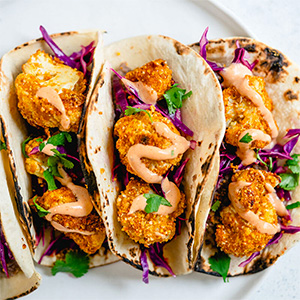3 recipes for serving oysters at home
Published in Variety Menu
PITTSBURGH — Most people have pretty strong opinions on the foods they love, and are just as vocal about the ones they hate.
My husband, for instance, cannot stand black licorice while I would never eat an anchovy. (At least we agree on cilantro and blue cheese.)
When it comes to the most polarizing foods, one that heads the list is the bumpy shellfish that's been around for millennia and was likely first eaten by prehistoric inhabitants of South African coastal regions some 164,000 years ago: oysters.
Known as bivalves because their shells have two parts, oysters are a pretty divisive food. Some diners are either put off by their unique salty flavor or can't stomach a raw oyster's gelatinous texture. Oftentimes, it's both.
"You either like them or are grossed out by them," says chef Adam Kucenic, who opened Pittsburgh's Muddy Waters Oyster Bar with his wife, Diane, in 2015. "For some, the texture is just a hard 'no' and a gag reflex almost, unfortunately."
That's especially true in landlocked cities like Pittsburgh, where there aren't as many oyster bars as places like Boston, Portland or New York.
"When we tell family or friends to go to an oyster bar, they're like 'ugh,'" Kucenic says with a laugh. "But when you go to other cities there's a huge culture for it, especially if it's where they're grown."
Others are put off by eating something that's technically still breathing when you slurp it, often with a squeeze of lemon or a sprinkle of mignonette sauce.
"You know, when you eat an oyster, it's still alive," Jim Wholey cautions me with a visible grimace when I ask the Pittsburgh fishmonger if he ever partakes.
Both sweet and savory recipes for oysters were mentioned in the 14th century English cookbook "The Forme of Cury," according to officials in Barnstable County, Massachusetts, which landed over 31.6 million oysters in 2021. By the mid-1600s, the Europeans who colonized the New World enjoyed the protein-rich seafood as a key part of their diet.
In colonial times, oysters harvested from the Chesapeake Bay rarely made it further than they could be transported in a day because their meat spoils very quickly once it's out of its shell. (Shucked oysters should be eaten as soon as possible after purchase, ideally within four hours.)
After the Civil War, advancements in food preservation and transportation — including better railroads, the introduction of refrigeration and improvements in canning — transformed the oyster industry, making it possible for them to be shipped far beyond the bay area to the Midwest.
Since they were both cheap (half the price of beef in 1909) and abundant, oysters were easy to find at the many oyster bars, cellars and lunchrooms that popped up in every city. During the great "oyster craze" of the late 1800s, they were so popular that the average New Yorker ate an average of 600 oysters per year, compared to less than three today for the average American.
"They were almost like chicken wings back then," says Kucenic. Pearl Street in New York City, in fact, is thought to have gotten its name from a Lenape shell midden in the area.
It all came crashing down in the 1900s thanks to a combination of overharvesting; pollution; the passage of the Pure Food and Drug Act in 1906, which required more stringent regulations for hygienic handling, packing, and shipping of food items; and some bad press that tied improperly handled oysters to typhoid outbreaks.
Fresh, and growing
Today, thanks to restoration efforts and advanced oyster farming techniques, there are aquaculture farms up and down the East Coast shoreline. Virginia is now the top oyster producer on the East Coast, harvesting roughly 300,000 bushels in 2023.
Started in 2001 with a $1,000 grant as a way to extend Cape Cod's "shoulder season," the annual Wellfleet (Massachusetts) OysterFest now draws close to 20,000 oyster lovers from across the U.S. and globe on the weekend following Columbus Day. It takes a year to plan.
"It was a bit of a challenge at first, because all the help was gone," recalls office coordinator Deirdre Oringer.
They also ran out of food in about 20 minutes. Two decades later, it's grown into a favorite holiday for visitors, who slurp some 50,000 raw and cooked oysters over the course of two days. Many also come to watch what's billed as the world's largest shucking contest, in which contestants race to shuck 24 oysters as quickly and accurately as possible. Chris Manocchio, a Toronto-based oyster shucker, took this year's title in 2 minutes,13 seconds.)
Wellfleet is known for its superior shellfish because its waters feature a strong tidal flow and level of salinity. "And we have a mixture of fresh and brackish water," says Oringer, noting it's important for optimal growth and flavor development.
While there are five main species of oysters consumed in the U.S., all oysters native to the East Coast come from the same species, Crassostrea virginica (Eastern oyster), notes Henry Dewey of Penn Avenue Fish Co. in the Strip District. Each has a different name because they're grown in different regions and different conditions, which leads to different flavors and textures.
"It's kind of like wines with terroir based on the soil and what's in the air," says Kucenic. "Oysters mirror what's in the water, with salt content the No. 1 factor."
One of the best known and most ubiquitous on the East Coast are Long Island's Blue Point, which have a medium salinity and medium minerality on the bite and finish. Chesapeake oysters are meatier and milder, with a low salt content. Malpeque from Canada offer a balance between sweet and salty.
Dewey's personal favorite, Blackberry Point oysters, which are harvested from the northwestern coast of the famed Prince Edward Island in northern Canada, have a mildly salty flavor and a sweet, clean finish.
"But I have rarely come across a bad oyster," he notes with a laugh.
One important note: The old wives' tale that oysters should be eaten only in months ending in "R" — which originated before refrigeration made it safe to transport them — no longer applies. Today, oysters are farmed year-round, including in summer, when water is warmer.
Nutritious and versatile
These days, oysters are often a luxury or special occasion food, perhaps because they're expensive at $3 or more apiece. Muddy Waters' Kucenic argues they're worth the price because oyster farming is the most sustainable farming in the ocean.
"It builds estuaries and emits oxygen," he says.
They're also very nutritious. Six medium raw oysters are only about 50 calories, but contain up to 12 grams of protein. They're also high in vitamin B12, zinc, iron and selenium and contain all nine essential amino acids in addition to a variety of other nutrients.
"And people say they're an aphrodisiac," Kucinic adds, though there's little science to support it.
Brinier oysters, like those from off the coast of Prince Edward Island in Canada, tend to be smaller and more expensive because oysters grow faster in warmer water. In Florida, oysters can grow to full size in about nine months while in Virginia it can take up to a year and a half. PEI oysters take 4-7 years to grow to market size of 3 inches.
Oysters are probably most famously eaten raw. But the plump and briny mollusks are actually a fairly versatile seafood, lending themselves to any numbers of different preparations.
They can be breaded and fried; baked in to a casserole; stirred with cream, bacon and potatoes into a creamy chowder; or baked in their shell along with spinach, onion and butter into a version of oysters Rockefeller, the dish Antoine's Restaurant in New Orleans created in 1899.
They're also terrific when grilled under a garlicky coat of breadcrumbs — especially on a cold day after a long run. My introduction to this recipe came after I ran across the Chesapeake Bay Bridge to Maryland's Eastern Shore as a celebratory treat following the 10K Bay Bridge Run. I've been craving them ever since.
True, it takes some time and effort to learn to shuck one, but many fish markets, including Whole Foods, will do it for you if you ask. You just have to keep them on ice and eat them within a couple hours to be safe.
Not sure how to go about it? Wholey's seafood manager John McNally suggests starting with a mild, sweet variety like a Chesapeake or Blue Point if you like salty.
Even better, imagine you're by the ocean with a cold beer, says Dewey.
"Eating oysters is all about ambiance ... where you are and who you're with," he says. "People are afraid they're going to be slimy, and they're not.
"They're briny. It's like a mouthful of ocean water."
A guided chef's tasting at an oyster bar like Muddy Waters, where you go from less to higher brine, can demonstrate the difference between varieties.
"It takes time to figure out what you like," says Kucenic.
------
Mignonette Sauce
PG tested
This easy recipe is a classic sauce for oyster and clams as well as other seafood.
1/4 cup finely minced shallots (1 or 2 shallots)
1/3 cup red-wine or white-wine vinegar
1 teaspoon coarsely ground black or white peppercorns
Pinch of sea salt
Mix together all the ingredients in a small bowl or jar until well blended. Cover and chill for at least 30 minutes before using. Mignonette will keep in the fridge for up to 1 month.
— The New York Times
Fried Oysters
PG tested
While any oyster can be fried — even canned — large varieties like the briny Chesapeake oysters I got from Wholey's in the Strip District are best. Some were so large, I had to cut them in half. I pan-fried them in vegetable oil.
1/2 cup all-purpose flour
Kosher salt and finely ground black pepper
6 shucked, meaty oysters
1 large egg, well beaten
1 cup panko bread crumbs
Vegetable oil or shortening, for frying
For tartar sauce
1 garlic clove, finely minced
Kosher salt
2 small shallots, minced
1 teaspoon capers, minced
4 cornichons, minced, or 1/3 cup minced dill pickle
1/2 cup mayonnaise (I used Duke's)
Juice of 1/2 lemon
Dash of hot sauce
1 tablespoon chopped fresh flat-leaf parsley, optional
Sliced lemon, for serving
Prepare oysters: Season flour with a generous pinch of salt and pepper. Dredge each oyster in the flour, dip in the beaten egg, then roll in the panko to evenly coat. Set aside on a baking sheet for a few minutes to dry and set; if not frying right away, place in refrigerator until you're ready cook.
Make tartar sauce: Mix minced garlic with a pinch of salt until sticky and pasty and place in small bowl. Add shallots, capers, minced pickles and toss to combine.
Stir in mayonnaise, lemon juice and a dash of hot sauce and stir well. Add chopped parsley and season to taste with salt. Refrigerate until ready to serve.
Fry the oysters: Melt enough oil or shortening in a deep medium skillet over medium heat until hot. It will be ready for frying oysters when a few crumbs of panko or the tip of a wooden chopstick sizzles actively in the fat.
Add oysters, working in batches as you have room. Fry until golden brown, 1-2 minutes, depending on size.
Remove with a slotted spoon or spider, and let rest on a clean rack while you fry the rest. Season each batch with a little salt while still piping hot, as soon as you pull them from the fat. Serve with tartar sauce and lemon slices.
Serves 2-3.
— Gretchen McKay, Post-Gazette
Muddy Waters Oyster Bar Char-Grilled Oysters
PG tested
The prep for these tasty oyster starters is so easy and the bivalves cook in minutes.
Cook's note: Place the oysters as flat as possible on the grates to avoid flareups (if tilted, the melted butter will drip onto the coals) and have a pair of tongs or grill gloves at the ready to remove them when they're done — the shells will be very hot! I used Blue Point oysters from Whole Foods.
1 dozen fresh oysters, shucked (with the flat side up)
1 stick ( 1/2 cup) unsalted butter, melted
4 cloves garlic, minced
1 tablespoon fresh parsley, finely chopped
1 tablespoon fresh oregano, finely chopped
1 tablespoon fresh lemon juice
1 teaspoon Worcestershire sauce
1 teaspoon hot sauce (adjust to taste)
1/2 teaspoon black pepper
1/2 cup grated Parmesan cheese
Lemon wedges for serving
French bread for serving
Heat your grill to medium high.
Shuck the oysters, ensuring they remain in their bottom shell and that none of the liquid spills out.
In a mixing bowl, combine melted butter, minced garlic, parsley, oregano, lemon juice, Worcestershire sauce, hot sauce and black pepper. Stir well to combine.
Spoon a generous amount of the garlic butter mixture onto each oyster, then top each one with Parmesan cheese.
Place oysters directly on the grill grates (as flat as possible) and grill for 5-7 minutes, or until the butter is bubbling, the cheese is melted and the edges of the oyster start to curl.
Remove the oysters from the grill and drizzle with any leftover butter mixture.
Serve immediately with lemon wedges and crusty bread.
Makes 12 oysters.
— Adam Kucenic, Muddy Waters Oyster Bar
Oysters Tomafella
PG tested
This simple spin on oysters Rockefeller comes from Tom, a customer at the Wellfleet Shellfishermen's Farmers Market. He recommends using maple or apple smoked bacon so it doesn't overpower the flavor of the oysters.
I made it with Blackberry Point oysters from Penn Avenue Fish Co. in the Strip District. It's a plump oyster harvested from the northwestern coast of Prince Edward Island that has a mild sweetness up front and a medium brininess on the finish. Owner Henry Dewey was kind enough to shuck them for me!
6 oysters on the half shell
1 tablespoon butter
1/4 medium sweet onion, diced
Handful of fresh spinach, chopped
Grated pecorino Romano cheese
2 strips bacon, cut into 1-inch strips
Preheat oven to 425 degrees.
Cover a baking sheet with a 1/4 -inch layer of kosher or rock salt. Preheat oven to 425 degrees.
Place the oysters on the baking sheet.
Melt butter in a saute pan, then add onions and cook until translucent. Add chopped spinach, mix thoroughly and cook until wilted, about 1 minute.
Place a spoonful of the spinach-onion mixture on each oyster. Sprinkle some grated cheese on top of each one and top with a couple strips of bacon,
Bake for 10-15 minutes, until the bacon is crispy. Serve straight from the oven.
Serves 2 as an appetizer.
— adapted from "Taste of Wellfleet: Celebrating the Food & Arts of Our Community" (Wellfleet Preservation Hall, 2021)
©2024 PG Publishing Co. Visit at post-gazette.com. Distributed by Tribune Content Agency, LLC.















Comments